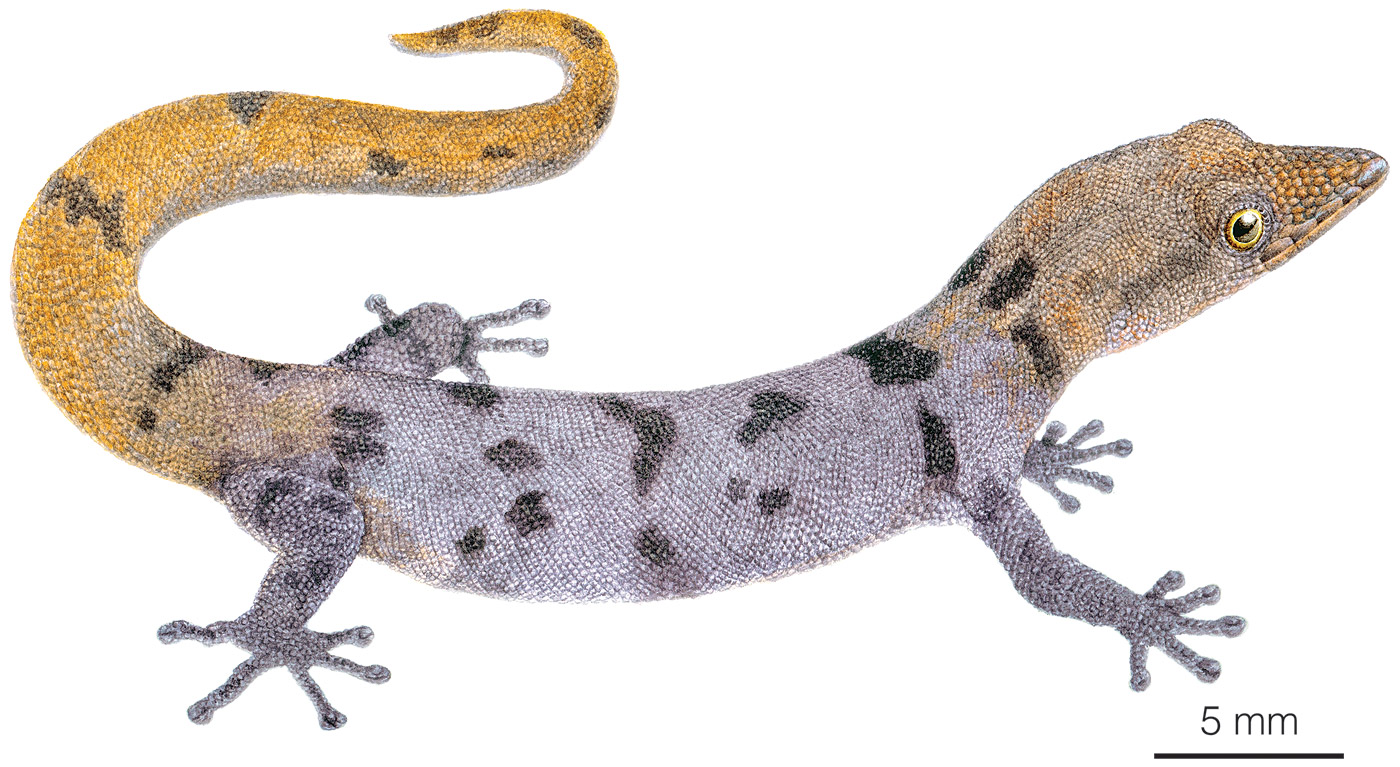Published January 10, 2024. Open access. | Purchase book ❯ |
Ecuadorian Palm-Gecko (Sphaerodactylus scapularis)
Reptiles of Ecuador | Sauria | Sphaerodactylidae | Sphaerodactylus scapularis
English common names: Ecuadorian Palm-Gecko, Boulenger’s Least Gecko.
Spanish common name: Geco palmera ecuatoriano.
Recognition: ♀♀ 6.9 cmMaximum distance from the snout to the tip of the tail. Snout–vent length=3.3 cm..1 Sphaerodactylus scapularis can be identified from other Ecuadorian dwarf geckos by having small and homogeneous dorsal scales and tips of digits expanded into disks, with the claw covered by an asymmetrical group of enlarged scales.1–4 Although males of this species are not known, in all other South American Sphaerodactylus, the males are characterized by a glandular abdominal shield, or escutcheon.1 This species differs from its congeners by having six dorsal bands or spots on the body and lacking any evidence of body scale keeling (Fig. 1).1,4 The dorsal coloration is drab purplish to yellowish brown, with dark cross-bands with uneven or irregular edges, often reduced to a mid-dorsal rhomboid spot.1

Figure 1: Illustration of an adult male of Sphaerodactylus scapularis.
Natural history: Sphaerodactylus scapularis is an extremely rare gecko, with less than 10 specimens assignable to this species ever found, leading some authors4 to question the validity of the species. These geckos have been found in lowland rainforest areas within 50 km from the coastline, but no more additional ecological data has been reported.1 However, a group of palm geckos presumably belonging to this species were seen active during the day on an abandoned building along the Ricaurte–Tumaco road in Nariño, Colombia.5 Members of the genus Sphaerodactylus in general are usually found on tree trunks, at the bases of coconut palms, under tree bark, and in man-made structures near the forest.6
Conservation: Critically Endangered Considered to be facing imminent risk of extinction. Sphaerodactylus scapularis is listed in this category, instead of Endangered,7 because it has an extremely small extent of occurrence, with only five known localities, and its habitat is severely fragmented and declining in extent and quality due to deforestation. All attempts to retrieve additional individuals of this species in both Ecuador3,5 and Colombia4,8 have failed. A recent, but unconfirmed observation in Colombia could correspond to this species. Otherwise, S. scapularis has remained “lost” for nearly 100 years.
Distribution: Sphaerodactylus scapularis is native to the Chocó biome in Ecuador (Fig. 2) and Colombia, including Gorgona Island.

Figure 2: Distribution of Sphaerodactylus scapularis in Ecuador. The star corresponds to the type locality: San Javier de Cachabi, Esmeraldas province. See Appendix 1 for a complete list of the presence localities included in the map.
Etymology: The generic name Sphaerodactylus comes from the Greek words sphaira (=ball) and daktylos (=finger),9 and refers to the shape of the digits. The specific epithet scapularis refers to the dark band across the scapular region, a characteristic mentioned in the description of the species.10
See it in the wild: Ecuadorian Palm-Geckos are undoubtedly the rarest geckos in the country, with only three confirmed observations. Although recent attempts to find this species have failed, it is possible that an expedition to the Río Cayapas could result in the rediscovery of the species.
Special thanks to Alain Kormann for symbolically adopting the Ecuadorian Palm-Gecko and helping bring the Reptiles of Ecuador book project to life.
Click here to adopt a species.
Author: Alejandro ArteagaaAffiliation: Fundación Khamai, Reserva Arlequín, Ecoruta Paseo del Quinde km 56, Santa Rosa de Mindo, Pichincha 171202, Ecuador.
Illustrator: Valentina Nieto Fernández
How to cite? Arteaga A (2024) Ecuadorian Palm-Gecko (Sphaerodactylus scapularis). In: Arteaga A, Bustamante L, Vieira J (Eds) Reptiles of Ecuador: Life in the middle of the world. Available from: www.reptilesofecuador.com. DOI: 10.47051/LCLW1170
Literature cited:
- Harris DM (1982) The Sphaerodactylus (Sauria: Gekkonidae) of South America. Occasional Papers of the Museum of Zoology, University of Michigan 704: 1–31.
- Peters JA, Donoso-Barros R (1970) Catalogue of the Neotropical Squamata: part II, lizards and amphisbaenians. Bulletin of the United States National Museum, Washington, D.C., 293 pp.
- MECN (2010) Serie herpetofauna del Ecuador: El Chocó esmeraldeño. Museo Ecuatoriano de Ciencias Naturales, Quito, 232 pp.
- Castro Herrera F, Ayala SC (1988) Saurios de Colombia. Unpublished, Bogotá, 692 pp.
- Field notes, Reptiles of Ecuador book project.
- Savage JM (2002) The amphibians and reptiles of Costa Rica, a herpetofauna between two continents, between two seas. The University of Chicago Press, Chicago, 934 pp.
- Velasco J, Bolívar W, Cisneros-Heredia DF (2015) Sphaerodactylus scapularis. The IUCN Red List of threatened species. Available from: www.iucnredlist.org. DOI: 10.2305/IUCN.UK.2015-4.RLTS.T178425A44954273.en
- Castro-Herrera F, Valencia-Aguilar A, Villaquirán-Martínez DF (2012) Diversidad de anfibios y reptiles del Parque Nacional Natural Isla Gorgona. Universidad del Valle, Cali, 112 pp.
- Brown RW (1956) Composition of scientific words. Smithsonian Books, Washington D.C., 882 pp.
- Boulenger GA (1902) Descriptions of new batrachians and reptiles from north-western Ecuador. Annals and Magazine of Natural History 9: 51–57. DOI: 10.1080/00222930208678538
Appendix 1: Locality data used to create the distribution map of Sphaerodactylus scapularis in Ecuador (Fig. 2). Go to the section on symbols and abbreviations for a list of acronyms used. Asterisk (*) indicates type locality.
| Country | Province | Locality | Source |
| Colombia | Nariño | Teherán | Higuera-Rojas et al. 2021 |
| Colombia | Nariño | Universidad Nacional de Colombia, sede Tumaco | Reptiles of Ecuador book database |
| Ecuador | Esmeraldas | Río Cayapas | Burt & Burt 1931 |
| Ecuador | Esmeraldas | Río Zapallo | Harris 1982 |
| Ecuador | Esmeraldas | San Javier de Cachabi* | Boulenger 1902 |